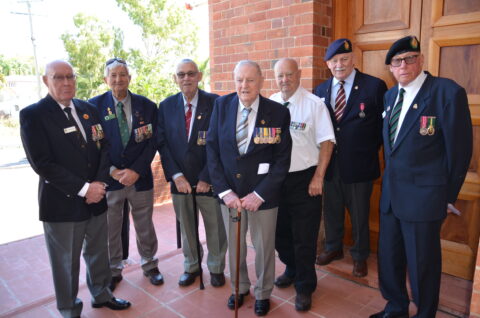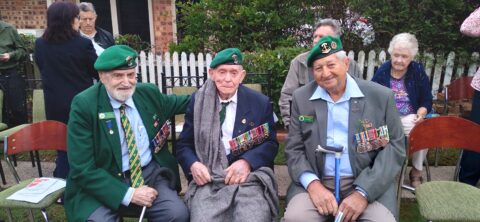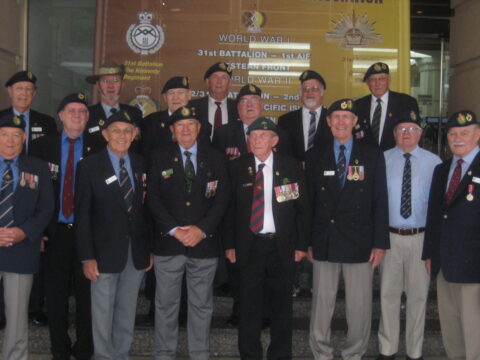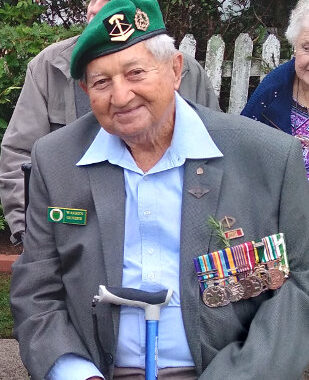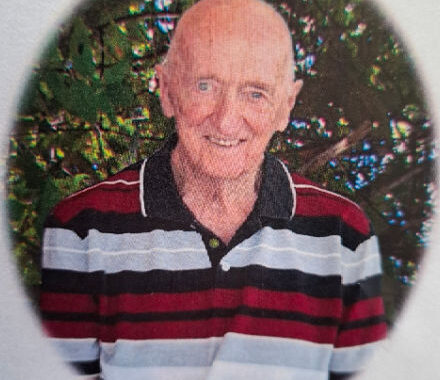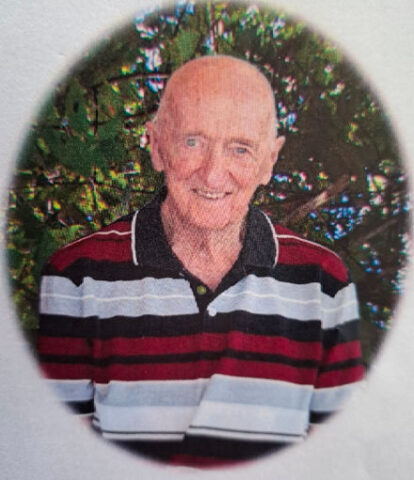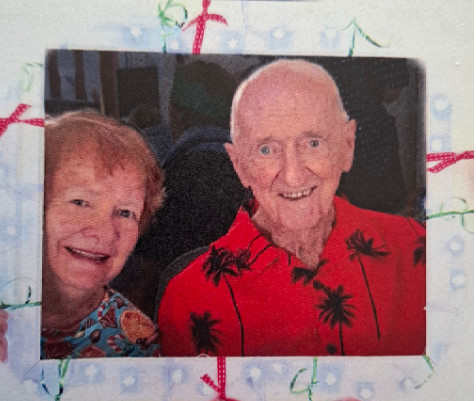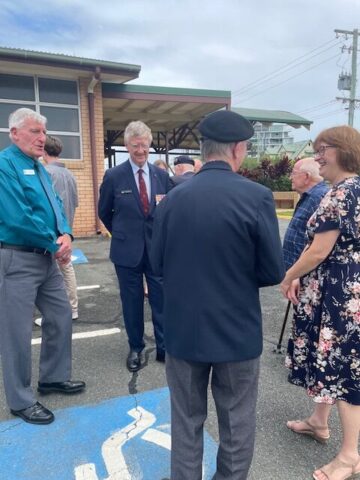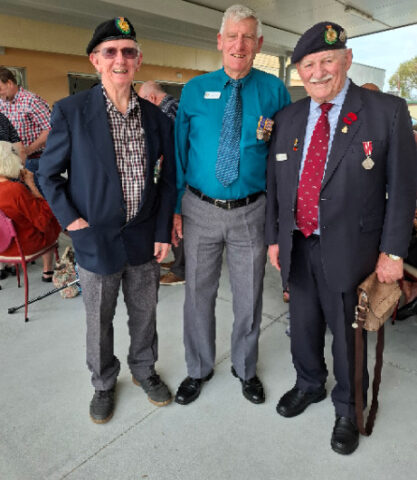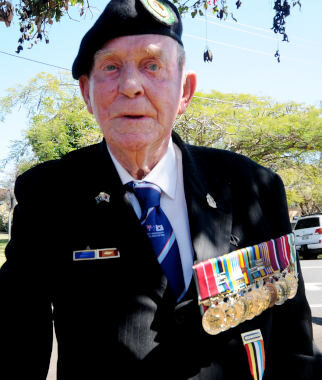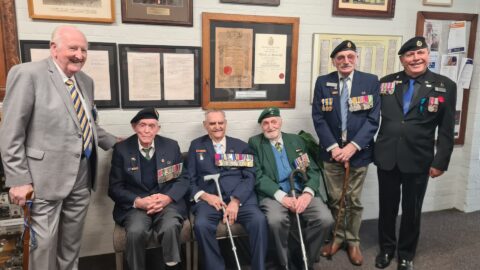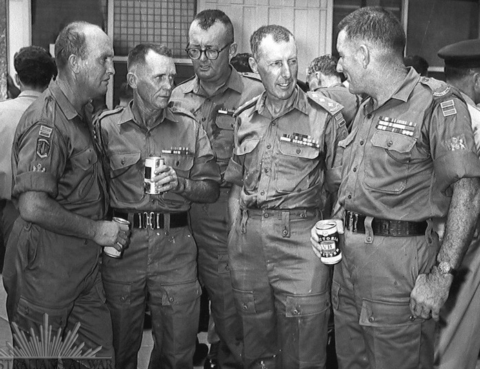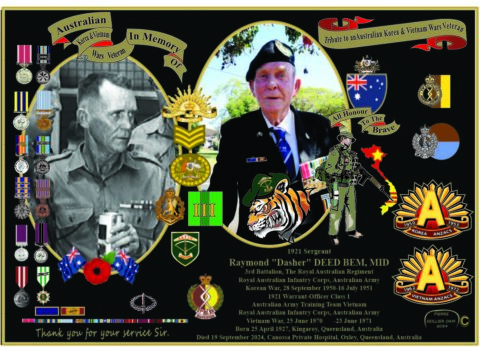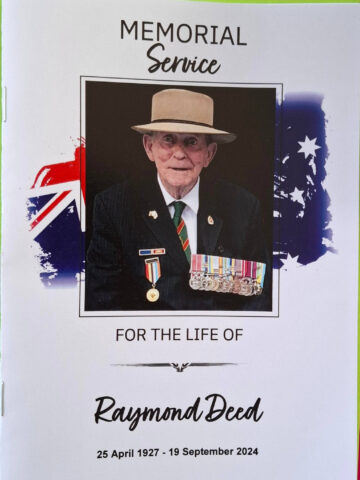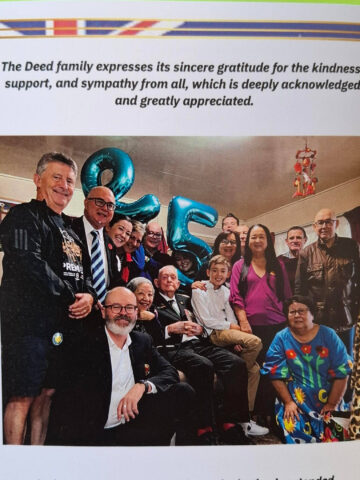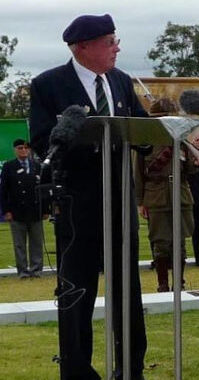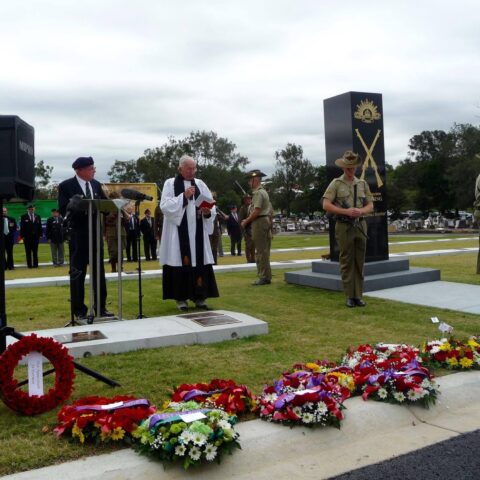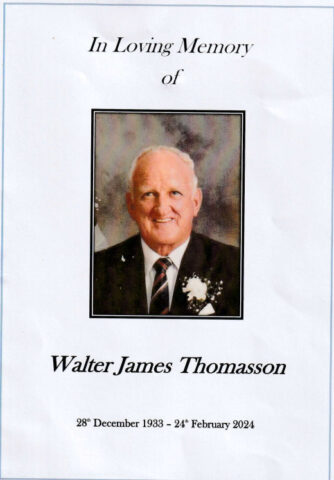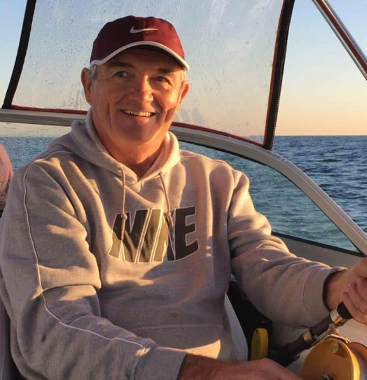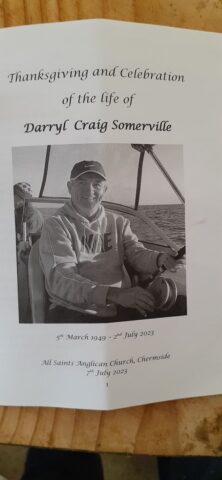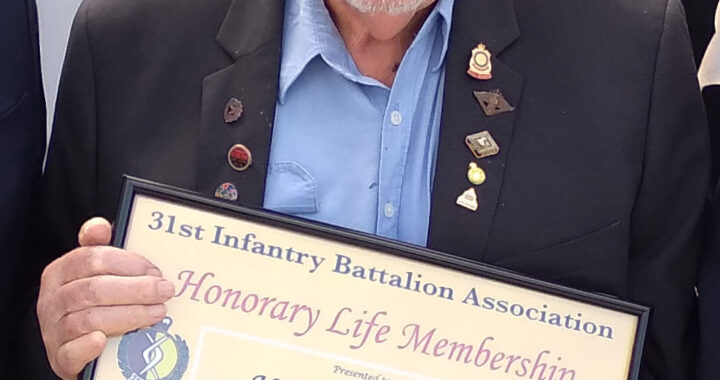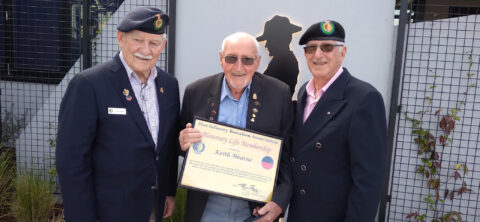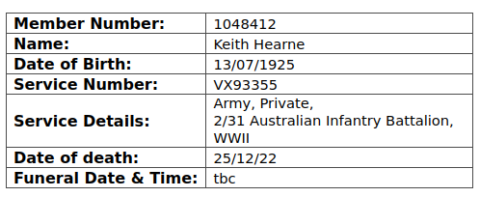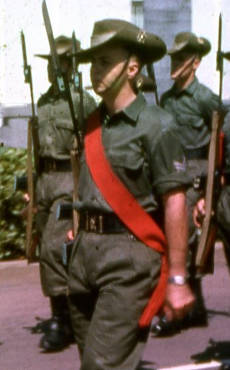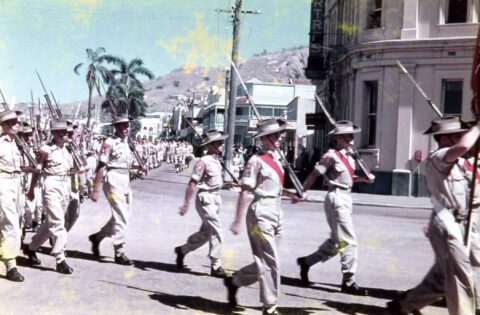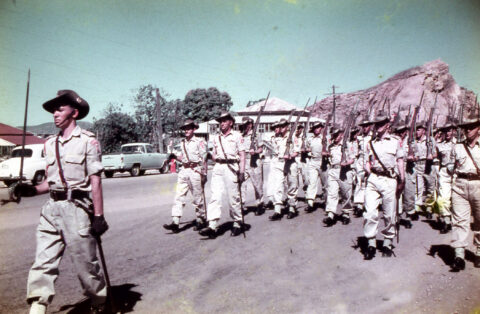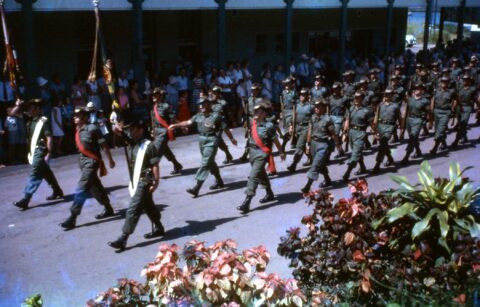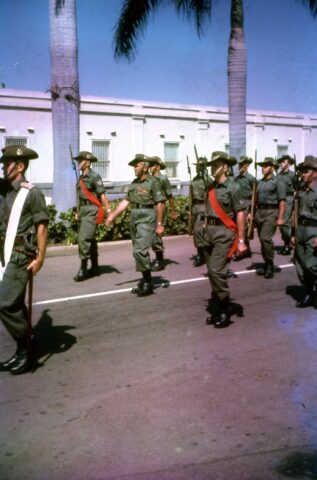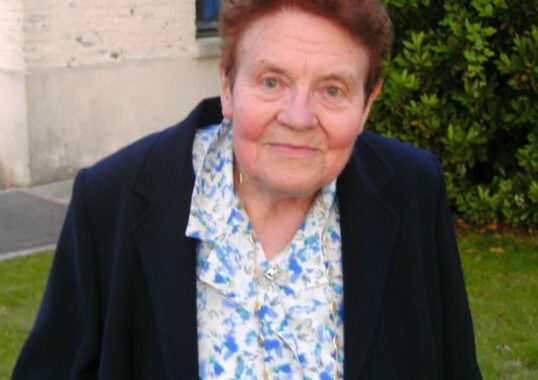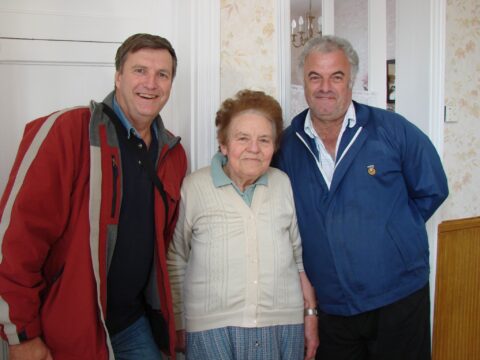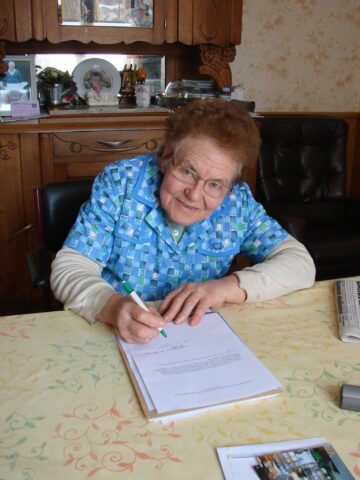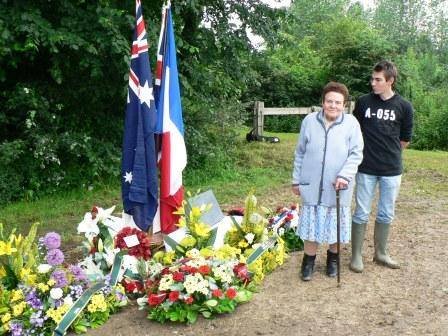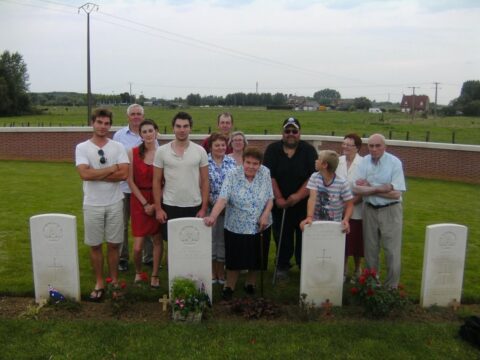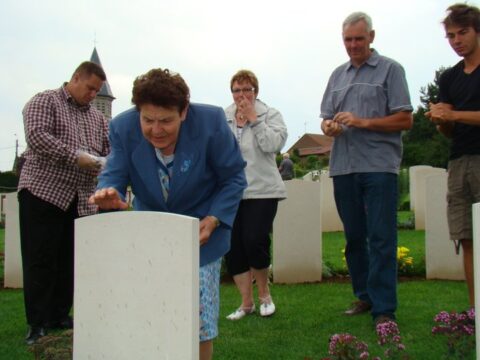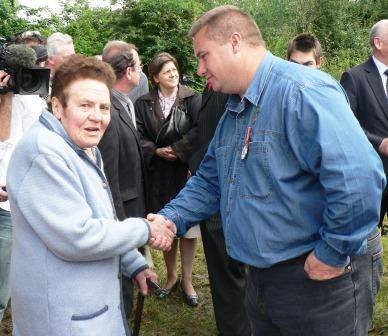On Thursday 6th February 2025 Members of the 31st Battalion Association and other Veterans joined members of the family in saying farewell to our member, LTCOL Bevin Wigan (Rtd). Bevin passed away on 30th January. A service was held at Our Lady of the Rosary Church at Caloundra
–
Bevin Joined 31st Bn in the mid Sixties. He transferred to the regular Army 1970 & served for a further 20 years as a regular Soldier in various postings in the Intelligence Corps. He has always been a staunch & dedicated member of the 31st Bn Association attending many of our Brisbane Meetings despite living in retirement on the Sunshine Coast, and in latter years, not always being in the best of health.
–
Each generation of the family were involved in various parts of the service celebrating Bevin’s life. The family have kindly allowed us to to use the extracts (below) from his Eulogy to highlight the life of a much respected member and Officer with whom many of us have had the pleasure and privilege of knowing and working.
–
Our thoughts go to Bevin’s Wife, Anette & His Family.
Rest in Peace Bevin
–
LtCol Bevin Osmond Wigan
–
Bevin and Annette
–
A Final Salute by 31st Bn Association Members and other Veterans
–
Association Members with Bevin’s Daughter, Michelle
–
Members (L to R) Martin O’Sullivan, Alan Bruce, and Tony Wadeson
–
The Eulogy was a well structured and well delivered tribute by Bevin’s sons. It started and continued to tell his story on a light hearted theme, likening the story of his life to a Saga that Hollywood would like to get their hands on.
–
“Townsville was where Dad and Mum began life together and dad worked with chemicals in the CSIRO, and soon after five children arrived, before moving into the army life.”
“Once their first house went up, Dad’s workmanship in concrete began. A trend that was to continue as we moved from place to place… along with the cement mixer.”
“To his credit his handy work remained standing after the Tropical Cyclone Althea hit in 1971. Well, most of it.”
“Then the moving began with a short tour to Melbourne where we lived in two different houses in a six-month period and discovered Dad’s love of AFL. We fondly remember a trip to see Collingwood play Hawthorn. Despite Dad being a staunch Carlton fan, his father followed Collingwood. We have many memories of AFL grand final parties which were made even more special if it was a Carlton and Collingwood match up.”
“Next a transfer to Canberra where Simon joined the team making us a family of 8 and Dad’s life as an intelligence officer began with him working at Australia’s version of the Pentagon and of course the cement mixer made a return.”
“Dad constructed two long retaining walls using the many large stones from the local hillside and our yard. He also created two long driveways and an entertainment area out the back.”
“Then one night dad brought home our first experience of Chinese food along with the message that if you don’t like this then I have some bad news for you.”
“We were heading to live in Singapore. The whole experience was like something out of a book. Opening our eyes to the world – where we developed an acceptance of different people and cultures.”
“We also learnt to shoot guns. It’s okay it was part of a school trip to the army base. Along with visiting the many naval vessels.”
“Dad … well he was doing what intelligence officers do … attending the country club … golf … overseas trips … martinis – shaken not stirred and the rest has been wiped from the record. No truth to the rumor that he was known as Double O Bevin.”
“After two years, we were back in Canberra for 12 months and the meat pie made a welcome return to the diet.”
“In a visit to Canberra recently, we found the house had been removed. The only things that remained were Dad’s two retaining walls and the cement out back with our initials still etched in the concrete.”
“We then had a shift to Brisbane and while dad worked in Canungra, he still found time to put in more concrete driveways.”
“Memories from this time include the many trips in the camper van. We looked forward to the adventure each holiday and it also meant we got to spend time with dad outside of his busy work schedule.”
“It was literally a military operation – organizing gear for six kids, food for the trip, the best route was calculated and all safety features checked off. Mum and Dad would have it all sorted and ready to roll out at 0600.”
“Then one night dad brought home hot dogs and apple pie along with the message well if you don’t like that then I have some bad news for you.”
“We are heading to live in USA. It was an amazing experience and totally due to the respect dad had gained in the international intelligence community.”
“Again, he did what intelligence officers do … attending the country club … golf … overseas trips. And Double O Bevin creates another chapter.”
“Along with the usual trips people take around the US, Disneyland, Grand Canyon, Niagara Falls, Florida, and New York City there was the bonus extra of been welcomed into the community and joining in the block parties celebrating American holidays particularly fourth of July, with Pig on the spit, hayrides and of course store bought fireworks.”
“When most people tour the Pentagon they get to the souvenir stand. But not so for Simon and Stephen (the littlies). They went with Double O Bevin past the souvenir stand, past the security guards, past the marines, down a number of levels, past the men in black …”
“Another example of Bevin’s work recognized, as he got to work closely with American Intelligence.”
“Then back to Canungra and meat pies were back on the menu. Memories of Walking through Canungra army barracks to go play squash and everyone saluting Dad as they walked past him. So Cool!”
“Hash House Harriers after running 3km through bush and Dad (as the boss) organising super large trays of chips and bread from the army kitchen.”
“Again, he did what intelligence officers do … attending the country club … the Canungra golf course where there were lots of quality games … of course if our dog (Pepsi) wasn’t chasing and stealing the balls.”
“Sydney was next on the list with the older children now at university and the younger two at boarding school. Mum and Dad finally had some peace and quiet with just Paul in the house. How’s the serenity. That was until holidays …”
“Then there was the return to Brisbane and exit of military life. With ‘the littlies’ in the final years of High school, Bevin became the first ‘Tuck-shop’ Dad and was affectionately nicknamed as ‘The Bevsta’ by the other students.”
“Now retired from the army, double-0-Bevin put his Intelligence skills to good use, gathering all the gossip from the tuck-shop mums, always making it difficult for us to get away with anything sneaky on the weekends (…not that we ever did anything sneaky).”
“Shortly after the Grandkids followed… all 20 and of course the latest addition, Caroline the “GGD””
“They are grateful for everything Grandad taught them and have many great memories of learning new things with every visit. Whether it was the phonetic alphabet, how to play chess or just having a sense of humour about things and having good people around you.”
“There was always something to look forward to whenever visited”
-
- Train rides to Maccas (with Grandmum) were the best
-
- Lots of things to do. Playing in the back yard full of pathways and gnomes and also the carving of Wilson, the stump man. You didn’t have to go far to have an adventure.
-
- Lolly snakes in the bottom of the ice cream cone and sprinkles on the Weetbix. The world famous BB cookies.
-
- The secret arm-in-arm handshake.
-
- Singing around the house with many songs … and we’re sure most were made up … something about wet cement and apparently “There’s a bear in there, and a Charlie as well”. And the classic “there were green alligators and long neck geese, humpty-back camels and chimpanzees, cats and rats and elephants and sure as you’re born but the loneliest of all was the unicorn”
“Granddad and Grandmum would come to visit no matter where we lived and watch sport or come to Grandparent’s Day and made us feel special.”
“We love that on all our adventures, our family has played games together, whether it be board games or card games. Where Tactics and playing by the rules were well instilled and just as important as winning. Developing a healthy level of competition that some may consider slightly over competitive.”
“Something we have all passed on to our grandkids and I’m sure they will pass it on to theirs…”
Always there to help
“Dad’s example of helping others through his involvement with the Church and Lifeline were influential in developing the values that hold us in good stead today.”
“Some solid advice received was:
“It’s great to do well and try your best but just remember, there may be someone bigger, stronger and faster just around the corner so don’t get too far ahead of yourself and enjoy what you achieve.”
“And these are just a few of the memories. Great support over the years and the grounding we received growing up.”
Role model
“We are the products of a wonderful and fortunate family. You and Mum have given us so much of yourselves over the years and have provided us with loving role models for our own families. Your calm approach to life’s challenges has provided us with tools to help us cope with changes and challenges we face. You’re always there for us with advice and support whenever we’ve needed it.”
“Bevin led a very rich life by doing things thoroughly without the fuss.
“He enriched all our lives”
-
- By valuing family – he made time for family and friends whenever he could
-
- By providing laughter with the never-ending dad jokes
-
- By always helping others in need
-
- By showing respect for others and he was in turn, respected by many
-
- And By his example of a strong sense of duty
“Bevin you were a wonderful person and role model – and we are all wealthier for having you in our lives.
We will always love you!
—
Thankyou to Bevin’s Family
